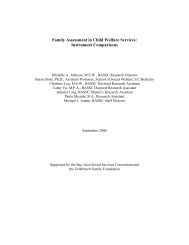CHAPTER 3: PROJECT RESULTS AND RECOMMENDATIONSThis project produced three instruments for collecting data on CLAS provision inLPHAs. By using the self-assessment tool, health care pr<strong>of</strong>essionals may examine theirown organizational policies and practices in relation to the extensive examples <strong>of</strong> CLASpractices listed in the tool itself. The tool’s questions and response options are designed toinform the respondent <strong>of</strong> a broad range <strong>of</strong> strategies and practices related to a particulartopic along the continuum <strong>of</strong> care. LPHAs may use the self-assessment tool to monitor andimprove overall health care quality in their agencies. Project results and recommendationsare described below.3.1 RESULTS3.1.1 Modification <strong>of</strong> the Project’s TitleAt the joint meeting <strong>of</strong> the PEP and PAG, members reached consensus on the need tochange the project’s title and scope from Local Health Departments (LHDs) to LocalPublic Health Agencies (LPHAs). Meeting participants mentioned that it was difficult toaccurately define LHDs, because LHDs are highly variable and are continuing to evolve.For instance, advisory group participants acknowledged that LHDs are <strong>of</strong>ten multijurisdictional,and there are other local public health entities (e.g., outreach programs,community health centers, and non-pr<strong>of</strong>it organizations) that would be excluded if LHDswere the primary focus <strong>of</strong> the self-assessment tool. To represent the (intended) moreinclusive terminology, the project title was changed to LPHAs, because the LHDs did notfully capture all local, publicly funded organizations responsible for providing essentialpublic health services.3.1.2 Overview <strong>of</strong> Revisions Made to CLAS InstrumentsDiscussions and deliberations at the PEP and PAG meeting yielded importantinformation on the structure and function <strong>of</strong> LPHAs and resulted in a number <strong>of</strong> necessaryrevisions to the three-component instrument used to measure CLAS provision in MCOs.Survey question wording and response options were revised to reflect LPHAcharacteristics. These revisions are described below and reflect the considerabledifferences between private and public health care entities, including differences inorganizational structure, size and operating budgets, mechanisms for developing policy,staffing and training, and service delivery practices.Organizational Structure. As described earlier, advisory group members informedOMH staff and the project team that LPHAs’ organizational structures vary from state tostate and even by county, and can be regulated by the state department <strong>of</strong> health and/or theCOSMOS Corporation, December 2003 3-1
local board <strong>of</strong> health. PEP and PAG members recommended to revise response options sothey reflect the variability in organizational structure.Staffing Practices. In addition, LPHAs hire state and county employees, and manytimes have volunteers on their staff. Therefore, response options were revised to reflectthese differences and took into consideration civil servant hiring practices.Training Practices. LPHAs do not fund training directly (i.e., do not have a line itemin their budget for training). Staff training is either funded by the state or the local board <strong>of</strong>health. Therefore, response options were revised to include, “training funded by the statehealth department” and “training funded by the local board <strong>of</strong> health.”Overall Item Terminology. The project team, in consultation with OMH staff and thePEP and PAG members, identified a number <strong>of</strong> terms found in the MCOs instruments thatneeded to be replaced with terminology that accurately represented LPHAs. For instance,while the MCO instruments included many items that made reference to an “organization,”the LPHAs instruments allude to an “agency.” Unlike MCOs, which are managed bysenior executives, LPHAs are managed by directors and some even by staff who serve inother capacities. Therefore, the instrument designated for MCO senior executives wasdesigned to be completed by the “local public health agency director or designee.”Also, the MCOs instruments included a number <strong>of</strong> items that discussed thecomposition <strong>of</strong> the board <strong>of</strong> directors. Because LPHAs are not managed by a board <strong>of</strong>directors, the revised instruments substituted the term with “board <strong>of</strong> health or othergoverning body.” In addition, unlike MCOs that serve members, wording was changed to“clients,” and “health care services” was substituted with “local public health services.”Response options that referred to a “corporate parent” were replaced with “state healthdepartment or other governing body” or “board <strong>of</strong> health or other governing body.”Finally, response options that include “corporate trainers” were replaced with “trainersprovided by the local board <strong>of</strong> health or other governing body.”3.1.3 Pilot Test Results for the LPHAs CLAS <strong>Self</strong>-<strong>Assessment</strong> ToolAfter the self-assessment tool’s three questionnaires were developed, a pilot studywas conducted with respondents similar to those who would be completing thequestionnaires. The purpose <strong>of</strong> the pilot study was to test the appropriateness and accuracy<strong>of</strong> the instrumentation (format and content).The pilot study was conducted between March and June 2002, and queried threeindividuals from each <strong>of</strong> the three participating LPHAs. The three respondentsrepresenting a LPHA included a director, a staffing personnel respondent, and a clientservices personnel respondent. These individuals were asked to review and providecomments on the format and content <strong>of</strong> the instruments. For each questionnaire componentCOSMOS Corporation, December 2003 3-2
- Page 1 and 2: Developing a Self-Assessment Toolfo
- Page 3 and 4: ContentsChaptersPage1. Introduction
- Page 5 and 6: Chapter 1Introduction
- Page 7 and 8: While many LPHAs currently provide
- Page 9 and 10: LPHAs include: adult and child immu
- Page 11 and 12: Professions Education Partnership A
- Page 13 and 14: Chapter 2Methodology for Developing
- Page 15 and 16: Public Health Practice Program Offi
- Page 17 and 18: assess their own beliefs and have k
- Page 19 and 20: communicate with, and clearly under
- Page 21 and 22: 2.1.6 Identifying Key Components of
- Page 23 and 24: Given these persistent disparities
- Page 25 and 26: (Exhibit 2-2, Continued)DOMAIN / KE
- Page 27 and 28: limited to the actual clinical enco
- Page 29: Chapter 3Project Results and Recomm
- Page 33 and 34: numerous promising CLAS practices a
- Page 35 and 36: References
- Page 37 and 38: Becker, M.H., and L.A. Maiman, “S
- Page 39 and 40: Frye, B., “Health Care Decision M
- Page 41 and 42: Marin, G., “Defining Culturally A
- Page 43 and 44: Perkins, Jane, “Overcoming Langua
- Page 45 and 46: U.S. Bureau of the Census, “Censu
- Page 47 and 48: Appendix AMembership Lists of the P
- Page 49 and 50: Appendix A-1Developing a Self-Asses
- Page 51 and 52: Appendix A-2Developing a Self-Asses
- Page 53 and 54: Appendix B-1Overview of Eight CLAS
- Page 55 and 56: Domain 3: Culturally Inclusive Heal
- Page 57 and 58: understanding of diversity issues i
- Page 59 and 60: Appendix B-2Conceptual Framework fo
- Page 61 and 62: Appendix CLPHA Director or Designee
- Page 63 and 64: Pre-Interview Script for LPHA Direc
- Page 65 and 66: 3b. Which of the following are refl
- Page 67 and 68: 6. Does your agency have a formal p
- Page 69 and 70: 10. Which of the following describe
- Page 71 and 72: Post-Interview Script for LPHA Dire
- Page 73 and 74: Appendix DStaffing Questionnaire
- Page 75 and 76: A. QUALITY MONITORING AND IMPROVEME
- Page 77 and 78: B. MANAGEMENT INFORMATION SYSTEMS (
- Page 79 and 80: 7. Please indicate, if you know, th
- Page 81 and 82:
1c. Please indicate for which categ
- Page 83 and 84:
6. Please indicate for which catego
- Page 85 and 86:
10. Which of the following topical
- Page 87 and 88:
17. Which of the following benefits
- Page 89 and 90:
4. Which of the following strategie
- Page 91 and 92:
Appendix EClient Services Questionn
- Page 93 and 94:
A. QUALITY MONITORING AND IMPROVEME
- Page 95 and 96:
6b.Which of the following community
- Page 97 and 98:
3. Please report or estimate what p
- Page 99 and 100:
3. Which of the following practices
- Page 101 and 102:
Oral Interpretation Services10. Whi
- Page 103 and 104:
16. At which of the following key e
- Page 105 and 106:
3. Which of the following kinds of
- Page 107 and 108:
Appendix FPilot Test Response Form
- Page 109 and 110:
RESPONDENT EVALUATIONOF THE QUESTIO
- Page 111 and 112:
Appendix GCLAS in MCOs Study Data C
- Page 113 and 114:
position, as titles will likely var
- Page 115 and 116:
complex and uncertain at the time t
- Page 117 and 118:
1. Incorporate a confirmation pre-c
- Page 119 and 120:
Exhibit 2DATA COLLECTION PROCESSSen
















